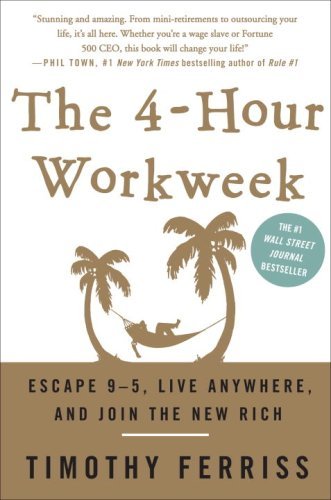
The 4-Hour Workweek (Check on GoodReads)
By Timothy Ferriss
First published: June 25, 2007
Categories: Nonfiction, Business, Self Improvement, Psychology, Productivity
01. Overall Summary.
The 4-Hour Workweek by Timothy Ferriss is a self-help book that challenges traditional notions of work and retirement. Ferriss presents a blueprint for escaping the 9-5 grind, achieving financial freedom, and living a more fulfilling life through principles like outsourcing, automation, and mini-retirements. The book combines personal anecdotes, practical advice, and case studies to illustrate how readers can redesign their lives for maximum efficiency and enjoyment.
02. Key Themes.
- Escape the 9-5 Work Culture: Challenges the traditional work model and encourages readers to break free from the standard office routine.
- Lifestyle Design and Freedom: Advocates creating a life where work supports personal goals, travel, and fulfillment rather than dominating time.
- Outsourcing and Automation: Promotes delegating tasks and automating processes to reclaim time and focus on what matters most.
- The Concept of Mini-Retirements: Suggests taking frequent breaks throughout life instead of saving all leisure for retirement.
- Overcoming Fear and Taking Action: Encourages confronting fears and using calculated risks to unlock personal freedom.
- The 80/20 Principle for Productivity: Teaches focusing on the few tasks that create the greatest results while eliminating time-wasting activities.
03. Main Characters/Protagonists.
Timothy Ferriss: The author and protagonist, who shares his personal journey from overworked entrepreneur to lifestyle designer. His motivation is to help others achieve freedom and fulfillment by working smarter, not harder.
04. Important Plot Points.
- Ferriss introduces the concept of the New Rich (NR), who prioritize time and mobility over traditional wealth.
- The book outlines the DEAL framework: Definition, Elimination, Automation, and Liberation.
- Ferriss shares his experiences with outsourcing his business to virtual assistants, allowing him to work only four hours a week.
- The idea of mini-retirements is presented as a way to enjoy life now rather than postponing happiness until traditional retirement.
- The book provides practical steps for automating income and reducing work hours.
”Focus on being productive instead of busy.
Timothy Ferriss
05. Author’s Purpose.
Timothy Ferriss aims to inspire readers to question conventional wisdom about work and retirement. He seeks to empower individuals to take control of their time and lives by leveraging technology, outsourcing, and smart work habits. The book is a call to action for those who feel trapped in the traditional work model to pursue a more fulfilling and efficient lifestyle.
06. Unique Elements.
- Use of Personal Anecdotes and Case Studies: Makes the advice relatable by sharing Ferriss’s own experiences and real-world examples.
- Practical, Step-by-Step Guides: Provides clear, actionable instructions rather than abstract theory.
- Emphasis on Outsourcing and Automation: Puts systems thinking at the center of work-life redesign.
- Introduction of the DEAL Framework: Offers a structured process—Definition, Elimination, Automation, Liberation—for achieving freedom.
- Focus on Mini-Retirements and Lifestyle Design: Reinvents retirement as a series of life experiences spread across a lifetime.
07. Personal Insights.
The 4-Hour Workweek resonates with readers who feel overwhelmed by the demands of modern work life. It offers a refreshing perspective on productivity and success, emphasizing that true wealth is measured in time and freedom, not just money. The book’s practical advice and real-world examples make it a valuable resource for anyone looking to redesign their life for greater efficiency and happiness.
08. Critical Reception.
The 4-Hour Workweek has received mixed reviews from critics and readers. Some praise its innovative ideas and practical advice, while others criticize it as unrealistic or overly simplistic. Despite the criticism, the book has become a bestseller and has inspired a movement of lifestyle designers and digital nomads. It has been translated into multiple languages and has a dedicated following.
*Disclaimer: As an Amazon Associate, I earn from qualifying purchases made through the links on this page. You pay the standard price at no additional cost to you.

